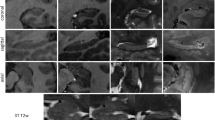Abstract
Recent emergence of 7.0T MR scanner sheds new light on the study of hippocampus by providing much higher image contrast and resolution. However, the new characteristics shown in 7.0T images, such as richer structural information and more severe intensity inhomogeneity, raise serious issues for the extraction of distinctive and robust features for accurately segmenting hippocampus in 7.0T images. On the other hand, the hand-crafted image features (such as Haar and SIFT), which were designed for 1.5T and 3.0T images, generally fail to be effective, because of the considerable image artifacts in 7.0T images. In this paper, we introduce the concept of unsupervised deep learning to learn the hierarchical feature representation directly from the pre-observed image patches in 7.0T images. Specifically, a two-layer stacked convolutional Independent Subspace Analysis (ISA) network is built to learn not only the intrinsic low-level features from image patches in the lower layer, but also the high-level features in the higher layer to describe the global image appearance based on the outputs from the lower layer. We have successfully integrated this deep learning scheme into a state-of-the-art multi-atlases based segmentation framework by replacing the previous hand-crafted image features by the hierarchical feature representations inferred from the two-layer ISA network. Promising hippocampus segmentation results were obtained on 20 7.0T images, demonstrating the enhanced discriminative power achieved by our deep learning method.
Access this chapter
Tax calculation will be finalised at checkout
Purchases are for personal use only
Preview
Unable to display preview. Download preview PDF.
Similar content being viewed by others
References
Zhou, J., Rajapakse, J.C.: Segmentation of subcortical brain structures using fuzzy templates. NeuroImage 28(4), 915–924 (2005)
Coupé, P., et al.: Patch-based segmentation using expert priors: Application to hippocampus and ventricle segmentation. NeuroImage 54(2), 940–954 (2011)
Khan, A.R., Wang, L., Beg, M.F.: FreeSurfer-initiated fully-automated subcortical brain segmentation in MRI using Large Deformation Diffeomorphic Metric Mapping. NeuroImage 41(3), 735–746 (2008)
Chupin, M., et al.: Automatic segmentation of the hippocampus and the amygdala driven by hybrid constraints: Method and validation. NeuroImage 46(3), 749–761 (2009)
van der Lijn, F., et al.: Hippocampus segmentation in MR images using atlas registration, voxel classification, and graph cuts. NeuroImage 43(4), 708–720 (2008)
Lötjönen, J.M.P., et al.: Fast and robust multi-atlas segmentation of brain magnetic resonance images. NeuroImage 49(3), 2352–2365
Cho, Z.-H., et al.: Quantitative analysis of the hippocampus using images obtained from 7.0 T MRI. NeuroImage 49(3), 2134–2140 (2010)
Wang, H., et al.: A learning-based wrapper method to correct systematic errors in automatic image segmentation: Consistently improved performance in hippocampus, cortex and brain segmentation. NeuroImage 55(3), 968–985 (2011)
Morra, J.H., Tu, Z., Apostolova, L.G., Green, A.E., Toga, A.W., Thompson, P.M.: Automatic Subcortical Segmentation Using a Contextual Model. In: Metaxas, D., Axel, L., Fichtinger, G., Székely, G. (eds.) MICCAI 2008, Part I. LNCS, vol. 5241, pp. 194–201. Springer, Heidelberg (2008)
Tu, Z., Bai, X.: Auto-Context and Its Application to High-Level Vision Tasks and 3D Brain Image Segmentation. IEEE Transactions on Pattern Analysis and Machine Intelligence 32, 1744–1757 (2010)
Zhang, S., Zhan, Y., Metaxas, D.N.: Deformable segmentation via sparse representation and dictionary learning. Medical Image Analysis 16(7), 1385–1396 (2012)
Zhang, S., et al.: Towards robust and effective shape modeling: Sparse shape composition. Medical Image Analysis 16(1), 265–277 (2012)
Bengio, Y.: Learning Deep Architectures for AI. Found. Trends Mach. Learn. 2(1), 1–127 (2009)
Shin, H.-C., et al.: Stacked Autoencoders for Unsupervised Feature Learning and Multiple Organ Detection in a Pilot Study Using 4D Patient Data. IEEE Transactions on Pattern Analysis and Machine Intelligence 99(PrePrints), 1 (2012)
Le, Q.V., et al.: Learning hierarchical invariant spatio-temporal features for action recognition with independent subspace analysis. In: 2011 IEEE Conference on Computer Vision and Pattern Recognition, CVPR (2011)
Author information
Authors and Affiliations
Editor information
Editors and Affiliations
Rights and permissions
Copyright information
© 2013 Springer International Publishing Switzerland
About this paper
Cite this paper
Kim, M., Wu, G., Shen, D. (2013). Unsupervised Deep Learning for Hippocampus Segmentation in 7.0 Tesla MR Images. In: Wu, G., Zhang, D., Shen, D., Yan, P., Suzuki, K., Wang, F. (eds) Machine Learning in Medical Imaging. MLMI 2013. Lecture Notes in Computer Science, vol 8184. Springer, Cham. https://doi.org/10.1007/978-3-319-02267-3_1
Download citation
DOI: https://doi.org/10.1007/978-3-319-02267-3_1
Publisher Name: Springer, Cham
Print ISBN: 978-3-319-02266-6
Online ISBN: 978-3-319-02267-3
eBook Packages: Computer ScienceComputer Science (R0)




